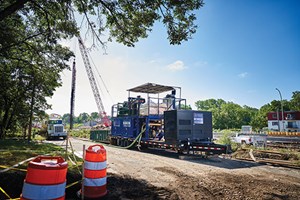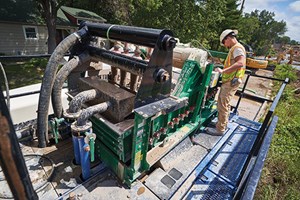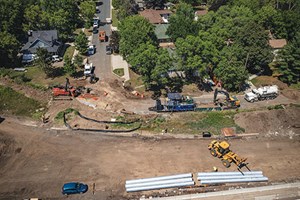September 2023 Vol. 78 No.9
Features
Let your fluid cleaning system be the hero
Contractor sees impressive results from new cleaning system
(UI) — Think of your favorite TV show or movie. There’s always a good guy, the protagonist, and a bad guy, the antagonist. Undoubtedly, at some point in the movie, the good guy will be put to the test and pushed to his limits to fight off the terrible actions of the bad guy. And, in any good movie, the good guy always wins.
In this movie, we’ll call it “Stay Up and Running – The Ballad of the Fluid Cleaning System,” the antagonist will be played by solid spoils in the drilling fluid. While this is a worthy adversary, our hero, the Fluid Cleaning System and the magic behind the scenes that makes it work, will come out on top.
The role of drilling fluid on an HDD jobsite is a big one. It acts as a conveyor for removing solids from the bore hole, lubricates downhole tooling, cools electronics and stabilizes the hole. Keeping it clean and usable is an important job, and an essential one for contractors to stay profitable.
Enter the Fluid Cleaning System. To keep all the equipment on the jobsite running at peak performance, the system needs to perform several tasks. First and foremost is to remove the maximum amount of solids as possible, which in turn, minimizes the waste disposal volume and returns clean fluids to the drill. Clean fluid running through the system greatly reduces the wear and tear on equipment, significantly reduces operating costs and maximizes downhole production.
Dress rehearsal
Don’t take our word for it though, take a look at what a new cleaning system did for one Texas contractor. With concerns regarding their existing mud system’s ability to recycle their drilling mud from their million-pound rig, they decided to upgrade.
Their rig typically circulates up to 1,200 gallons per minute (gpm) and can drill up to 72-inch holes. It was paired with a mud recycling system consisting of two conventional scalping shakers, followed by one desander shaker and one desilter shaker running flat, pretensioned screens. The contractor could not pump the desired rates downhole due to capacity limitations of the mud system, which also produced wetter-than-desirable cuttings at times, which increased disposal costs, commercial solids and water usage.
The new and upgraded system, an American Augers MCD1200, featured two Derrick Hyperpool shakers for primary screening, while the third unit, fitted with a three-cone inline desander package, followed by a fourth unit fitted with a 20-cone inline desilter package, would handle finer particle separation.
After more than a year of running the new system, the contractor has seen great results. Solids off the Hyperpool shakers are significantly dryer than the conventional shakers produced, thereby allowing the contractor to load the trailers with more material, reducing the number of daily loads for disposal. They saw a reduction in haul off costs, due to a reduced number of trucks from four to 2 and costing approximately $3,000 a day.
There also was a great reduction in non-productive time, with an estimated one to 2 more hours per drilling shift. Finally, the contractor saw increased handling capacity, comfortably handling up to 1,000 gpm from two 6-inch trash pumps. Prior to the new system, they had only been able to handle returns from one pump.
Each contractor experiences a different benefit from an upgraded fluid cleaning system. Some mainly note the savings in haul off costs, while others speak to the environmental benefits and low sand content in the recycled fluid. All the benefits add up to the same result – more uptime and profit.
Final scene
After contractors have ensured they have the right sized cleaner for their operation, they need to think about who is going to run the system. Oftentimes, “the new guy” gets put on cleaner duty, which isn’t necessarily a bad thing. Just because a contractor has a brand-new cleaner with game-changing capabilities does not mean it will be successful. A well-trained crew is essential.
Luckily, many OEMs, like American Augers and Derrick, offer in-depth training. There are online versions, where training can be completed remotely, and there are in-person offerings. All contractors need to do is check with their local Ditch Witch dealer to learn about these training opportunities.
FOR MORE INFORMATION:
American Augers, (800) 324-4930, americanaugers.com
Derrick Equipment Company, 866-DERRICK, derrickinternational.com







Comments